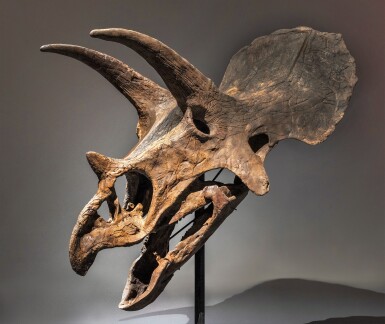
Triceratops Skull
Auction Closed
July 28, 03:27 PM GMT
Estimate
250,000 - 350,000 USD
Lot Details
Description
Triceratops Skull
Triceratops horridus
Late Cretaceous (approx. 66 million years ago)
Hell Creek Formation, South Dakota
90 inches (228 cm) long, 57 inches (145 cm) wide, supraorbital brow horns each measuring approx. 36½ inches (93 cm) in length, nasal horn measuring approx. 7¾ inches (20 cm) in length. Height of 92½ inches (235 cm) when mounted on custom stand. Estimated weight of 441 pounds (200 kg).
Specimen shows good condition preserving natural surface detail of the bone. Both the large frill and supraorbital brow horns clearly display numerous pits and deep branching grooves which once housed foramina and nutrient canals that supplied blood to the outer bone sheaths. Reconstructed sections are accurately finished.
The herbivorous Triceratops (meaning "three-horned face") is undoubtedly one of the world's best-known and most popular dinosaurs, due in great part to their distinctive bony frills, keratinous beaks, and three-horned skulls. Fearsome in appearance, their horns were long-considered to serve a primarily defensive function, though recent speculation suggests that the horns may have also or instead been used in intraspecific courtship and/or dominance displays.
The large bony collar at the rear of the Triceratops skull functioned as a shield, protecting the neck and shoulders from attack by large predators, such as Tyrannosaurus rex, which lived in the same region at the same time. Based on pathologies found in numerous fossils, it is now known that these two iconic dinosaurs engaged in frequent battle, as has often been represented in dinosaur media.
This particular species of Triceratops was first discovered in Wyoming by John Bell Hatcher in 1886, and belongs to the Ceratopsidae family, characterized by beaks, rows of shearing teeth in the back of the jaw, elaborate nasal horns, and a bony shelf that extends back and up into a frill. Ceratopsids belong to the larger Ornithischian order, which includes all dinosaurs with "bird-like" hips and beak-like predentary structures.
